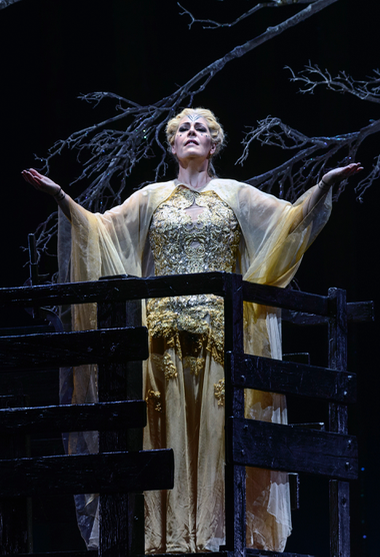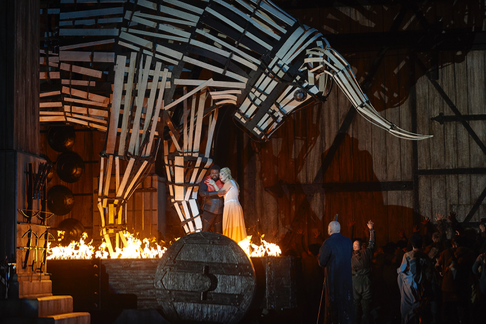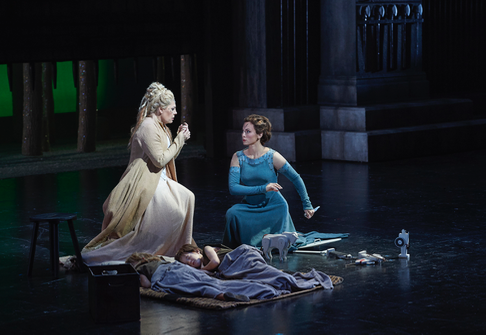
24 Oct 2016
Toronto: Bullish on Bellini
Canadian Opera Company has assembled a commendable Norma that is long on ritual imagery and war machinery.
English Touring Opera are delighted to announce a season of lyric monodramas to tour nationally from October to December. The season features music for solo singer and piano by Argento, Britten, Tippett and Shostakovich with a bold and inventive approach to making opera during social distancing.
This tenth of ten Live from London concerts was in fact a recorded live performance from California. It was no less enjoyable for that, and it was also uplifting to learn that this wasn’t in fact the ‘last’ LfL event that we will be able to enjoy, courtesy of VOCES8 and their fellow vocal ensembles (more below …).
Ever since Wigmore Hall announced their superb series of autumn concerts, all streamed live and available free of charge, I’d been looking forward to this song recital by Ian Bostridge and Imogen Cooper.
The Sixteen continues its exploration of Henry Purcell’s Welcome Songs for Charles II. As with Robert King’s pioneering Purcell series begun over thirty years ago for Hyperion, Harry Christophers is recording two Welcome Songs per disc.
Although Stile Antico’s programme article for their Live from London recital introduced their selection from the many treasures of the English Renaissance in the context of the theological debates and upheavals of the Tudor and Elizabethan years, their performance was more evocative of private chamber music than of public liturgy.
In February this year, Albanian soprano Ermonela Jaho made a highly lauded debut recital at Wigmore Hall - a concert which both celebrated Opera Rara’s 50th anniversary and honoured the career of the Italian soprano Rosina Storchio (1872-1945), the star of verismo who created the title roles in Leoncavallo’s La bohème and Zazà, Mascagni’s Lodoletta and Puccini’s Madama Butterfly.
Evidently, face masks don’t stifle appreciative “Bravo!”s. And, reducing audience numbers doesn’t lower the volume of such acclamations. For, the audience at Wigmore Hall gave soprano Elizabeth Llewellyn and pianist Simon Lepper a greatly deserved warm reception and hearty response following this lunchtime recital of late-Romantic song.
Collapsology. Or, perhaps we should use the French word ‘Collapsologie’ because this is a transdisciplinary idea pretty much advocated by a series of French theorists - and apparently, mostly French theorists. It in essence focuses on the imminent collapse of modern society and all its layers - a series of escalating crises on a global scale: environmental, economic, geopolitical, governmental; the list is extensive.
For this week’s Live from London vocal recital we moved from the home of VOCES8, St Anne and St Agnes in the City of London, to Kings Place, where The Sixteen - who have been associate artists at the venue for some time - presented a programme of music and words bound together by the theme of ‘reflection’.
'Such is your divine Disposation that both you excellently understand, and royally entertaine the Exercise of Musicke.’
Amongst an avalanche of new Mahler recordings appearing at the moment (Das Lied von der Erde seems to be the most favoured, with three) this 1991 Mahler Second from the 2nd Kassel MahlerFest is one of the more interesting releases.
‘And there was war in heaven: Michael and his angels fought against the dragon; and the dragon fought and his angels, And prevailed not; neither was their place found any more in heaven … that old serpent … Satan, which deceiveth the whole world: he was cast out into the earth, and his angels were cast out with him.’
If there is one myth, it seems believed by some people today, that probably needs shattering it is that post-war recordings or performances of Wagner operas were always of exceptional quality. This 1949 Hamburg Tristan und Isolde is one of those recordings - though quite who is to blame for its many problems takes quite some unearthing.
There was never any doubt that the fifth of the twelve Met Stars Live in Concert broadcasts was going to be a palpably intense and vivid event, as well as a musically stunning and theatrically enervating experience.
‘Love’ was the theme for this Live from London performance by Apollo5. Given the complexity and diversity of that human emotion, and Apollo5’s reputation for versatility and diverse repertoire, ranging from Renaissance choral music to jazz, from contemporary classical works to popular song, it was no surprise that their programme spanned 500 years and several musical styles.
The Academy of St Martin in the Fields have titled their autumn series of eight concerts - which are taking place at 5pm and 7.30pm on two Saturdays each month at their home venue in Trafalgar Square, and being filmed for streaming the following Thursday - ‘re:connect’.
The London Symphony Orchestra opened their Autumn 2020 season with a homage to Oliver Knussen, who died at the age of 66 in July 2018. The programme traced a national musical lineage through the twentieth century, from Britten to Knussen, on to Mark-Anthony Turnage, and entwining the LSO and Rattle too.
With the Live from London digital vocal festival entering the second half of the series, the festival’s host, VOCES8, returned to their home at St Annes and St Agnes in the City of London to present a sequence of ‘Choral Dances’ - vocal music inspired by dance, embracing diverse genres from the Renaissance madrigal to swing jazz.
Just a few unison string wriggles from the opening of Mozart’s overture to Le nozze di Figaro are enough to make any opera-lover perch on the edge of their seat, in excited anticipation of the drama in music to come, so there could be no other curtain-raiser for this Gala Concert at the Royal Opera House, the latest instalment from ‘their House’ to ‘our houses’.
"Before the ending of the day, creator of all things, we pray that, with your accustomed mercy, you may watch over us."

Canadian Opera Company has assembled a commendable Norma that is long on ritual imagery and war machinery.
Perhaps you cannot be blamed if you prefer your Druid tale to be more concerned with the love triangle that propels the story but love be damned, it cannot be denied that Director Kevin Newbury conspired with his set designer David Korins to keep impending violence in the forefront.
Mr. Korins has devised a playing environment that begins life as an armory, with heavy stone walls festooned with all manner of ancient weaponry. But hold on, he wants to have it both ways, so the huge double door flies away revealing rows of pale tree trunks, that tie in to the visual of the huge, severed, bare white tree that is suspended horizontally up center. Two enormous bull heads flank the upstage false proscenium, hovering ominously as symbols of the preferred sacrificial animal of Druid rites.
A gentle snow falls but rather than suggesting serenity it conveys a barrenness, a void of passion that would prove all too prophetic. And problematic. Significant scenic additions to this playing environment included a rolling, rustic, two-tiered wagon that may have wandered in out of an English Mystery Play. It existed solely to allow Oroveso and Norma a method of gaining focus by mounting the second level to address the populace like a politician working partisan supporters.
 The immolation
The immolation
And then there is . . .the bull. A giant, Trojan-horse-cum-bull made of rude wooden slats and set on a wheeled platform rolls on up right in the final scene to become the funeral pyre. Handsome enough as a sculpture, it was in the wrong place at the wrong time, first stealing, then lacking focus; proving awkward for Pollione and Norma to access; and decidedly unfrightening. As the “pyre” starts burning, it is safely and neatly contained along the front edge of the platform, clearly unthreatening, and it fires up well before the lovers can scramble into place for the effect. So, the big finish fizzled and amounted to just a lotta overwrought “bull.”
Jessia Jahn’s costumes had just the right primitive look along with a commendable variety. She made especially beautiful choices for Adalgisa, alluring in a simple blue gown, and Norma, radiant in sumptuous gold attire and blond wig. By making Norma look totally foreign to the rest of the citizenry, it was easy to believe that her “otherness” contributed to her veneration as a priestess. Duane Schuler is a renowned lighting designer whose his effects did not disappoint. Although some of the sudden color washes (red, green, etc.) seemed bluntly executed, they were obviously in collegial support of some rather blunt directorial choices.
Not that Kevin Newbury’s theatrical guidance did not have good intentions and some fresh ideas. Crowd management and motivation of group entrances/exits were well conceived overall, with only one instance of awkwardness when the chorus (and Oroveso) were left without a motivated focus. The smaller ensembles contained so many moments of meaningful interaction that it seemed a shame that there were also conspicuous lapses with characters upstaging each other, while doing their best to get out of the way of the focal singer.
Norma began the show on stage holding a torch aloft, a nice premonition of her fate, although it did deprive her of Bellini’s star entrance later in the scene. I liked the Druid “salute,” a “dap” variation on the sign of the cross that was well incorporated and conveyed a fine sense of communal religious observances. I was less persuaded by manufactured bits like having a group of female supers cross the stage bearing black stools just prior to the first Norma-Adalgisa duet, and being persuaded to leave two stools en route stage left so that the two soloists could “sit and chat.” It also rang false that those two leads casually folded the children’s blankets and played with their toys during the conclusion of their second duet! There is a bit more at stake at that point than tidying up the nursery like giggly schoolgirls.
If the staging sometimes called attention to itself, the performers were able to maintain musical integrity and make a solid case for Bellini’s masterpiece. In the pit, Stephen Lord led a robust, refined account of the score and the players responded with real, purposeful dramatic fire. The splendid cello solo was but one of many instrumental high points, and the entire ensemble excelled under Maestro Lord’s knowing baton.
The role of Norma is a “big sing” of course, and world star Sondra Radvanovksy more than fulfilled expectations. Is there anyone in the business that has a firmer command of her technique than Ms. Radvanovsky? She knows what she wants to do, what she can do, and has the wisdom to know the difference. And in an age when many voices sound somewhat anonymous, her instrument is recognizable and uniquely personal.
The soprano is never heard to better advantage than when she is ravishing us with beautifully controlled filigrees of pianissimo passages. Caballe, Sills and Scotto were past mistresses of this effect, and I would be hard pressed to name any current performer who is Sondra’s equal at this intense, hushed soft singing. It is when she presses harder that her tone can come to grief, with high notes that are admirably secure nonetheless taking on an occasional harsh, metallic tinge.
Still, the diva performs with total mastery of her art, both musically and theatrically. If her turn as Norma is not quite the complete triumph it may become, it is owing to a certain cerebral calculation of effects which are meticulously judged but somewhat wanting in spontaneity and emotional honesty. I have seen Ms. Radvanovksy be incredibly moving and genuine on past occasions, but on this night I was more aware of her consummate craft than her personal commitment.
 Sondra Radvanovsky as Norma, Isabel Leonard as Adalgisa
Sondra Radvanovsky as Norma, Isabel Leonard as Adalgisa
We are spoiled by the perfection of legendary Norma-Adalgisa match-ups like Sutherland-Horne, Callas-Cossotto, Caballe-Verrett, or presently, Meade-Barton. It has to be said the luminous Isabel Leonard is a very affecting Adalgisa, and her plush, throbbing mezzo-soprano is thing of refined beauty indeed. Ms. Leonard is such a sympathetic presence, her bearing at once determined and contrite, that I wish she had been a better vocal match for her co-star. Her rounded, suave delivery had all the requisite coloratura at her command, but explosive phrases were executed within the vocabulary of her own distinctive, gentler firepower. The duets were always well-coordinated and cleanly managed, only at odds in tonal approach.
Russell Thomas proved to be an engrossing Pollione, his burnished, meaty tenor caressing plangent phrases one minute and hurling out riveting declamations the next. I had enjoyed Mr. Thomas some years ago as a promising Hoffmann, but nothing could have prepared me for the assertive star turn he provided in Norma. He is deservedly maturing into a major artist on the international scene. Dimitry Ivashchenko was a sturdy Oroveso, although his ample bass could turn hard when pushed for dramatic volume rather than deployed for musical finesse.
Young Charles Sy had pleasing tone to spare as he put his well-schooled tenor in good service of Flavio’s several scenes. Aviva Fortunata made a highly favorable impression, her attractive, substantial soprano imbuing each of Clotilde’s phrases with such real quality that it reminds us the great Sutherland once herself made quite an impression in this secondary role.
James Sohre
Cast and production information:
Oroveso: Dimitry Ivashchenko; Pollione: Russell Thomas; Flavio: Charles Sy; Norma: Sondra Radvanovsky; Adalgisa: Isabel Leonard; Clotilde: Aviva Fortunata; Conductor: Stephen Lord; Director: Kevin Newbury; Set Design: David Korins; Costume Design: Jessica Jahn; Lighting Design: Duane Schuler; Chorus Master: Sandra Horst.